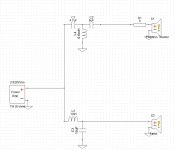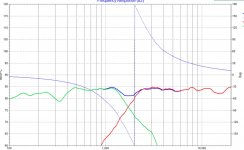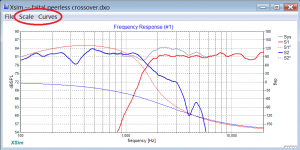Hello Everyone! First time in a forum since the old days of DTMpower (the early 2000s)
I recently have been building DIY audio projects and I have dove deeper into the rabbit hole with this latest build. I did not want to use a prebuilt passive crossover nor rely on an active configuration like mini DSP so I began to research crossover design and ended up taking Audio Judgement's Udemy course on room acoustics and crossover design. 100% worth the 30 bucks I spent.
So I have spent a few days tinkering with XSim for the drivers I have ordered and I get a good response and a good phase correction (i think that is what its called) Then I go to parts express to order parts and the parts I used are not available or super expensive. What I have below is the closest thing I can get with available parts that don't cost hundreds of dollars. This configuration is $51 and has a good phase correction but it has a 3db dip at the crossover point. Will I actually notice that? I know that I can use active to correct and I will use REW for room corrections but I hate it not being as linear as I think it can be, well I know it can be more linear it just costs gobs of money...I'm not paying 200 bucks for a single inductor.
Secondly, the midbass has a pretty nasty dip around 300hz and nothing I do seems to remotely affect that so what is the best course of action there? I come from the car audio world so my first reaction is to add another driver to the equation like a tang band w5 and have like a 2 1/2 way setup and let the tang band handle a bit of the 80-400 bit subtlety to create a more linear response in the room... am I overthinking a 4db dip here or is my train of thought correct?
Anyways thanks for any advice, happy to have found a DIY audio platform to participate in.

I recently have been building DIY audio projects and I have dove deeper into the rabbit hole with this latest build. I did not want to use a prebuilt passive crossover nor rely on an active configuration like mini DSP so I began to research crossover design and ended up taking Audio Judgement's Udemy course on room acoustics and crossover design. 100% worth the 30 bucks I spent.
So I have spent a few days tinkering with XSim for the drivers I have ordered and I get a good response and a good phase correction (i think that is what its called) Then I go to parts express to order parts and the parts I used are not available or super expensive. What I have below is the closest thing I can get with available parts that don't cost hundreds of dollars. This configuration is $51 and has a good phase correction but it has a 3db dip at the crossover point. Will I actually notice that? I know that I can use active to correct and I will use REW for room corrections but I hate it not being as linear as I think it can be, well I know it can be more linear it just costs gobs of money...I'm not paying 200 bucks for a single inductor.
Secondly, the midbass has a pretty nasty dip around 300hz and nothing I do seems to remotely affect that so what is the best course of action there? I come from the car audio world so my first reaction is to add another driver to the equation like a tang band w5 and have like a 2 1/2 way setup and let the tang band handle a bit of the 80-400 bit subtlety to create a more linear response in the room... am I overthinking a 4db dip here or is my train of thought correct?
Anyways thanks for any advice, happy to have found a DIY audio platform to participate in.


There's more than one way to skin a cat.
Caps can be paralleled to achieve the desired value.
Inductors can be wound or unwound a few turns.
Caps can be paralleled to achieve the desired value.
Inductors can be wound or unwound a few turns.
Yea and inverted I have a pretty decent phase correction notch (or whatever its called i dont quite remember)You likely already tried this, but maybe reversing polarity of the high pass driver?
I had not considered that. I have tried caps in series and that didnt have the desired effect but never ever considered stacking them.There's more than one way to skin a cat.
Caps can be paralleled to achieve the desired value.
Inductors can be wound or unwound a few turns.
With the inductors what measuring system would one use to get it dialed in? EG. I buy a 2.2 and i need a 1.7 what do i measure it with as im unwrapping to know when i get to 1.7?
It looks like it could use more baffle step correction which will likely require a larger inductor.
That is a bit more advanced than I know at this point 🙂It looks like it could use more baffle step correction which will likely require a larger inductor.
I remember baffle step correction in the course but I think i glazed over that bit. I actually don't know how to identify that issue, I can reference the video lesson on how to correct it but Im not sure where the problem in my response is...I cant see it
I dont know what you mean?Why have you turned off the display of phase?
You ought to be seeing a phase trace for each of your woofer and tweeter. That way you can see what you are doing between them. Working with an inverted notch is not the right way to use a simulator.
- Home
- Design & Build
- Construction Tips
- New to the forum and new to xover design... 3db dip at xover point...Should I fix it?
